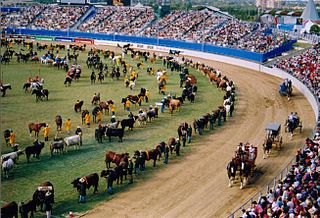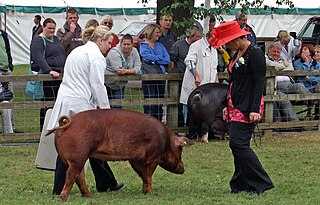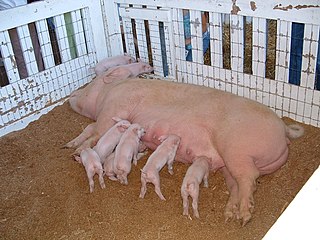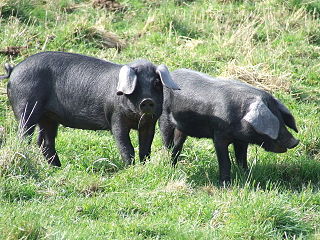
An agricultural show is a public event exhibiting the equipment, animals, sports and recreation associated with agriculture and animal husbandry. The largest comprise a livestock show, a trade fair, competitions, and entertainment. The work and practices of farmers, animal fanciers, cowboys, and zoologists may be displayed. The terms agricultural show and livestock show are synonymous with the North American terms county fair and state fair.

The Gloucestershire Old Spots is an English breed of pig which is predominantly white with black spots. It is named after the county of Gloucestershire. The Gloucestershire Old Spots pig is known for its docility, intelligence, prolificity, and hardiness. Boars reach a mature weight of 600 lb (272 kg) and sows 500 lb (227 kg). The pigs are white with clearly defined black spots. There must be at least one spot on the body to be accepted in the registry. The breed's maternal skills enable it to raise large litters of piglets on pasture. Its disposition and self‑sufficiency should make it attractive for farmers raising pasture pigs and those who want to add pigs to diversified operations.

The Tamworth is a British breed of domestic pig. It is the only red-coloured British pig. Its origins are unknown, but it appears to have developed near the town of Tamworth in south-eastern Staffordshire, close to Warwickshire border. It is one of seven British pig breeds listed by the Rare Breeds Survival Trust as 'priority', the highest level of concern of the trust.

The American Landrace is an American breed of domestic pig. It is white in color, with a long body, fine hair, a long snout and heavy, drooping ears. Like all landrace pigs, it derives from the Danish Landrace.

The Duroc pig is an older breed of domestic pig. The breed was developed in the United States and formed the basis for many mixed-breed commercial hogs. Duroc pigs are reddish-brown and golden yellow, large-framed, medium length, and muscular, with partially-drooping ears. They tend to be one of the least aggressive of all swine breeds raised for meat.

The American Yorkshire is an American breed of large domestic pig. It is the most numerous pig breed in the United States. It derives from pigs of the British Large White or Yorkshire breed imported from the United Kingdom or from Canada at various times from about 1830 to the mid-twentieth century.
Mulefoot are a breed of domestic pig which is named for its intact, uncloven hooves reminiscent of a mule.

The Poland China is an American breed of domestic pig. It was first bred in Warren County in Ohio, in the American Midwest. Its origins lie in a small number of pigs of Chinese type bought in 1816, which were cross-bred with a variety of breeds of European origin including the Berkshire. It was bred as a lard pig, and is among the largest of all pig breeds.

The Large Black pig is a British breed of domestic pig. It is the only British pig that is entirely black. It was created in the last years of the nineteenth century by merging the black pig populations of Devon and Cornwall in the south-west with those of Essex, Suffolk and Kent in the south-east. It is hardy, docile and prolific; it forages well and is suitable for extensive farming, but not well suited to intensive management.

The Red Wattle Hog is a breed of domestic pig originating in the United States. It is named for its red color and distinctive wattles or tassels, and is on the threatened list of the American Livestock Breeds Conservancy (ALBC).

The Choctaw Hog is a breed of domestic pig historically used by Native Americans. They are now reduced in population to some hundred animals, most of them in the Choctaw Nation of Oklahoma. The American Livestock Breeds Conservancy calls the Choctaw Hog's status "critically rare" and says it "is a high conservation priority."

The American Milking Devon is an American breed of dual-purpose cattle, reared both for milk and for beef. It derives from the Devon cattle of the United States, which in turn are derived from the North Devon cattle of south-west England. It was established as a separate breed in 1978 with the formation of the American Milking Devon Cattle Association, after the breeding aims of the Devon were concentrated almost exclusively on beef production. It is a rare breed: its conservation status is listed as by the Livestock Conservancy as 'critical'.

Miniature Pigs, also called mini pig, or Pygmy pig, or teacup pig, are small breeds of domestic pig. There a two types of mini pig: small traditional pig breed like the Vietnamese Pot-Bellied pig, the Choctaw hog and even smaller newer breeds like Göttingen minipig and Juliana pig.

The Meishan is a breed of domestic pig named for the Meishan, Jiangsu Province, China. It is a sub-group of the Taihu pig and is a small to medium-sized breed with large drooping ears, and wrinkled black skin. Meishan Pigs are extremely docile and renowned for their tender and flavorful red meat pork.

The Ossabaw Island Hog or Ossabaw Island is a breed of pig derived from a population of feral pigs on Ossabaw Island, Georgia, United States. The original Ossabaw hogs are descended from swine released on the island in the 16th century by Spanish explorers. A breeding population has been established on American farms off the island, but they remain a critically endangered variety of pig.

The British Landrace is a British domestic breed of pig and one of the most popular in the United Kingdom. It is pink with heavy drooping ears that cover most of the face and is bred for pork and bacon. The breed originated in the 1949 importation of 12 landrace pigs from Scandinavia — four boars and eight gilts. In 1950, the British Landrace Pig Society was formed and it opened a herd book for the first offspring born from the imported 12. They created the first pig testing scheme with a testing station at the village of Stockton-on-the-Forest in North Yorkshire.

The Hereford Hog or Hereford is an American breed of domestic pig. It is named for its color and pattern, which is similar to that of the Hereford breed of cattle: red with a white face.
The Lacombe is a breed of domestic pig native to Canada. Named for the Lacombe Research and Development Centre in Lacombe, Alberta, the breed was the first strain of livestock developed in the country.
















